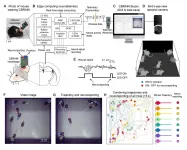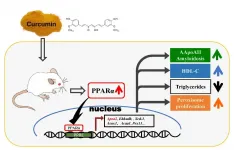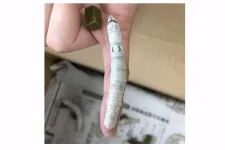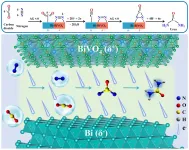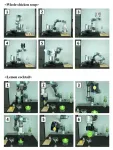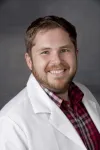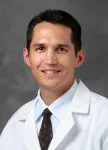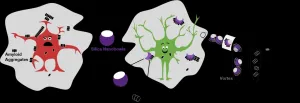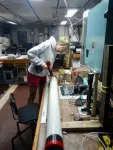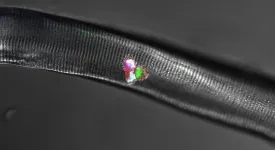Can a robot operate effectively underwater?
2021-02-26
If you've ever watched Planet Earth, you know the ocean is a wild place to live. The water is teaming with different ecosystems and organisms varying in complexity from an erudite octopus to a sea star. Unexpectedly, it is the sea star, a simple organism characterized by a decentralized nervous system, that offers insights into advanced adaptation to hydrodynamic forces--the forces created by water pressure and flow.
Researchers from the USC Viterbi School of Engineering found that sea stars effectively stay attached to surfaces under extreme hydrodynamic loads by altering their shape. The researchers, including the Henry Salvatori Early Career Chair in Aerospace and Mechanical Engineering Mitul Luhar and doctoral ...
Early-warning for seizures could be a game-changer for epilepsy patients
2021-02-26
Epilepsy is one of the most common neurological conditions, affecting more than 65 million worldwide. For those dealing with epilepsy, the advent of a seizure can feel like a ticking time bomb. It could happen at any time or any place, potentially posing a fatal risk when a seizure strikes during risky situations, such as while driving.
A research team at USC Viterbi School of Engineering and Keck Medicine of USC is tackling this dangerous problem with a powerful new seizure predicting mathematical model that will give epilepsy patients an accurate warning five minutes to one hour before they are likely to experience a seizure, offering enhanced freedom for the patient and cutting the need for medical intervention.
The research, ...
MicroRNA testing of healthy kids could provide a window on future heart and kidney health
2021-02-26
New York, NY (February 26, 2020) - Molecules called microRNAs (miRNAs) that are measurable in urine have been identified by researchers at Mount Sinai as predictors of both heart and kidney health in children without disease. The epidemiological study of Mexican children was published in February in the journal Epigenomics.
"For the first time, we measured in healthy children the associations between urinary miRNAs and cardiorenal outcomes, including blood pressure, urinary sodium and potassium levels, and eGFR [estimated glomerular filtration rate, a measure of how well the kidneys are filtering or cleaning the blood]," says lead author Yuri Levin-Schwartz, ...
Flickering the neural activities with LED lights
2021-02-26
Living in a group has clear benefits. As a member of a societal group, one can share resources with the others, seek protection from predators, and forage in an efficient manner. In a 2020 paper published in Science Advances, the neuroscientist Jee Hyun Choi and her student Jisoo Kim of the Brain Science Institute in the Korea Institute of Science and Technology (KIST) argue that there are much more stories about the advantages of group living and social behaviors to the mammalian brain yet to be discovered. Their research was conducted using CBRAIN (Collective Brain Research Aided by Illuminating Neural activity), a unique neuro-telemetric device equipped with LED lights, which enables the ...
Curcumin for amyloidosis and lipid metabolism -- a novel insight
2021-02-26
Curcumin is a polyphenol compound produced by plants of the Curcuma longa species and has been reported to have many physiological activities, which include anti-oxidation, anti-inflammatory, anti-cancer, and anti-amyloid properties. However, the mechanism and network of action are not completely clear. Amyloidosis is a group of diseases characterized by abnormal aggregates of proteins, known as amyloid fibrils, and subsequent deposition in various tissues and organs, such as Alzheimer's disease, immunoglobulin light chain amyloidosis.
In previous studies, curcumin has been ...
Changing the silkworm's diet to spin stronger silk
2021-02-26
Tohoku University researchers have produced cellulose nanofiber (CNF) synthesized silk naturally through a simple tweak to silkworms' diet. Mixing CNF with commercially available food and feeding the silkworms resulted in a stronger and more tensile silk.
The results of their research were published in the journal Materials and Design on February 1, 2021.
"The idea for our research came to us when we realized the flow-focusing method by which silkworms produce silk is optimal for the nanofibril alignment of CNF," said Tohoku University materials engineer Fumio Narita and co-author of the study.
Silk is usually associated with clothes. But its usage is incredibly diverse thanks to its strength and elastic properties. Its biocompatibility makes it even safe to ...
New open-source platform accelerates research into the treatment of heart arrhythmia's
2021-02-26
An open-source platform, OpenEP co-developed by researchers from the School of Biomedical Engineering & Imaging Sciences at King's College London has been made available to advance research on atrial fibrillation, a condition characterised by an irregular and often fast heartbeat. It can cause significant symptoms such as breathlessness, palpitations and fatigue, as well as being a major contributor to stroke and heart failure.
Current research into the condition involves the interpretation of large amounts of clinical patient data using software written by individual ...
Using artificial intelligence to hunt for breast cancer
2021-02-26
The centre is part of the German Federal Institute for Risk Assessment (BfR). With the help of microscopy and artificial intelligence, the "E-Morph" test reliably identifies substances that can have oestrogen-like or even opposing effects, according to the research team's report in the specialist journal "Environment International". "E-Morph is a milestone on the way to, one day, replacing animal experiments currently required to detect hormone-like effects," says BfR President Prof. Dr. Dr. Andreas Hensel.
Link to the specialist publication (ScienceDirect):
https://www.sciencedirect.com/science/article/pii/S0160412021000350
Link ...
Advantageous preparation of movement via independent control of muscle sensors
2021-02-26
A number of brain areas change their activity before we execute a planned voluntary movement. A new study by Umeå University identifies a novel function of this preparatory neural activity, highlighting another mechanism the nervous system can use to achieve its goals.
Voluntary movements are prepared before they are executed. For example, such 'preparation' occurs in the period between seeing a coffee cup and starting to reach for it. Neurons in many areas of the brain change their activity during movement preparation in ways that reflect different aspects of ...
"Stark warning": Combating ecosystem collapse from the tropics to the Antarctic
2021-02-26
Eminent scientists warn that key ecosystems around Australia and Antarctica are collapsing, and propose a three-step framework to combat irreversible global damage.
Their report, authored by 38 Australian, UK and US scientists from universities and government agencies, is published today in the international journal Global Change Biology. Researchers say I heralds a stark warning for ecosystem collapse worldwide, if action if not taken urgently.
Lead author, Dr Dana Bergstrom from the Australian Antarctic Division, said that the project emerged from a conference inspired by her ecological research in polar environments.
"I was seeing unbelievably rapid, widespread dieback in the alpine tundra of World Heritage-listed Macquarie Island and started wondering if this ...
Novel catalysts improve efficiency of urea synthesis at ambient conditions
2021-02-26
Converting both nitrogen (N2) and carbon dioxide (CO2) into value-added urea molecules via C-N coupling reaction is a promising method to solve the problem of excessive CO2 emissions.
Compared with huge energy consumption industrial processes, the electrochemical urea synthesis provides an appealing route under mild conditions. However, it still faces challenges of low catalytic activity and selectivity.
A research team led by Prof. ZHANG Guangjin from the Institute of Process Engineering (IPE) of the Chinese Academy of Sciences fabricated Bi-BiVO4 Mott-Schottky heterostructure catalysts for efficient urea synthesis at ambient conditions.
This work was published in Angewandte Chemie International ...
KIMM develops all-round grippers for contact-free society
2021-02-26
The Korea Institute of Machinery and Materials (KIMM) successfully developed all-round gripper* technology, enabling robots to hold objects of various shapes and stiffnesses. With the new technology, a single gripper can be used to handle different objects such as screwdrivers, bulbs, and coffee pots, and even food with delicate surfaces such as tofu, strawberries, and raw chicken. It is expected to expand applications in contact-free services such as household chores, cooking, serving, packaging, and manufacturing.
*Gripper: A device that enables robots to hold and handle objects, ...
Researcher identifies potential new measure for Alzheimer's risk
2021-02-26
Memphis, Tenn. (February 25, 2021) - Early diagnosis of Alzheimer's disease has been shown to reduce cost and improve patient outcomes, but current diagnostic approaches can be invasive and costly. A recent study, published in the Journal of Alzheimer's Disease, has found a novel way to identify a high potential for developing Alzheimer's disease before symptoms occur.
Ray Romano, PhD, RN, completed the research as part of his PhD in the Nursing Science Program at the University of Tennessee Health Science Center College of Graduate Health Sciences. Dr. Romano conducted the research through the joint laboratory of Associate ...
Diversity among study participants credited with identifying gene linked to asthma
2021-02-26
DETROIT (February 25, 2021) - Researchers at Henry Ford Health System, as part of a national asthma collaborative, have identified a gene variant associated with childhood asthma that underscores the importance of including diverse patient populations in research studies.
The study is published in the print version of the American Journal of Respiratory and Critical Care Medicine.
For 14 years researchers have known that a casual variant for early onset asthma resides on chromosome 17, which holds one of the most highly replicated and significant genetic associations with asthma. Henry Ford researchers acknowledged they would not have identified it in this study ...
Nanoparticles help untangle Alzheimer's disease amyloid beta plaques
2021-02-26
ROCKVILLE, MD - Scientists are still a long way from being able to treat Alzheimer's Disease, in part because the protein aggregates that can become brain plaques, a hallmark of the disease, are hard to study. The plaques are caused by the amyloid beta protein, which gets misshapen and tangled in the brain. To study these protein aggregates in tissue samples, researchers often have to use techniques that can further disrupt them, making it difficult to figure out what's going on. But new research by Vrinda Sant, a graduate student, and Madhura Som, a recent PhD graduate, in the lab of Ratnesh Lal at the University of California, San Diego, provides a new technique for studying amyloid beta and could be useful in future Alzheimer's treatments. Sant and her colleagues will present their research ...
Social media use driven by search for reward, akin to animals seeking food
2021-02-26
Our use of social media, specifically our efforts to maximize "likes," follows a pattern of "reward learning," concludes a new study by an international team of scientists. Its findings, which appear in the journal Nature Communications, reveal parallels with the behavior of animals, such as rats, in seeking food rewards.
"These results establish that social media engagement follows basic, cross-species principles of reward learning," explains David Amodio, a professor at New York University and the University of Amsterdam and one of the paper's authors. "These findings may help us understand why social media comes to dominate daily life for many people and provide clues, borrowed from research on reward learning and addiction, to how troubling online engagement may ...
New catalyst makes styrene manufacturing cheaper, greener
2021-02-26
Chemical engineering researchers have developed a new catalyst that significantly increases yield in styrene manufacturing, while simultaneously reducing energy use and greenhouse gas emissions.
"Styrene is a synthetic chemical that is used to make a variety of plastics, resins and other materials," says Fanxing Li, corresponding author of the work and Alcoa Professor of Chemical Engineering at North Carolina State University. "Because it is in such widespread use, we are pleased that we could develop a technology that is cost effective and will reduce the environmental impact of styrene manufacturing." Industry estimates ...
Retroviruses are re-writing the koala genome and causing cancer
2021-02-26
The koala retrovirus (KoRV) is a virus which, like other retroviruses such as HIV, inserts itself into the DNA of an infected cell. At some point in the past 50,000 years, KoRV has infected the egg or sperm cells of koalas, leading to offspring that carry the retrovirus in every cell in their body. The entire koala population of Queensland and New South Wales in Australia now carry copies of KoRV in their genome. All animals, including humans, have gone through similar "germ line" infections by retroviruses at some point in their evolutionary history and contain many ancient retroviruses in their genomes. These retroviruses have, over millions of years, mutated into degraded, inactive forms that are no longer harmful to the host. Since in most animal ...
URI researchers: Microbes deep beneath seafloor survive on byproducts of radioactive process
2021-02-26
NARRAGANSETT, R.I. - February 26, 2021 - A team of researchers from the University of Rhode Island's END ...
The key to proper muscle growth
2021-02-26
When a muscle grows, because its owner is still growing too or has started exercising regularly, some of the stem cells in this muscle develop into new muscle cells. The same thing happens when an injured muscle starts to heal. At the same time, however, the muscle stem cells must produce further stem cells - i.e., renew themselves - as their supply would otherwise be depleted very quickly. This requires that the cells involved in muscle growth communicate with each other.
Muscle growth is regulated by the Notch signaling pathway
Two years ago, a team of researchers led by Professor Carmen Birchmeier, head of the Developmental Biology/Signal Transduction ...
Improving water quality could help conserve insectivorous birds -- study
2021-02-26
A new study shows that a widespread decline in abundance of emergent insects - whose immature stages develop in lakes and streams while the adults live on land - can help to explain the alarming decline in abundance and diversity of aerial insectivorous birds (i.e. preying on flying insects) across the USA. In turn, the decline in emergent insects appears to be driven by human disturbance and pollution of water bodies, especially in streams. This study, published in END ...
Vitamin B6 may help keep COVID-19's cytokine storms at bay
2021-02-26
Who would have thought that a small basic compound like vitamin B6 in the banana or fish you had this morning may be key to your body's robust response against COVID-19?
Studies have so far explored the benefits of vitamins D and C and minerals like zinc and magnesium in fortifying immune response against COVID-19. But research on vitamin B6 has been mostly missing. Food scientist END ...
Not all "good" cholesterol is healthy
2021-02-26
HDL cholesterol (high-density lipoprotein cholesterol) or good cholesterol is associated with a decreased risk of cardiovascular disease as it transports cholesterol deposited in the arteries to the liver to be eliminated. This contrasts with the so-called bad cholesterol, LDL (low-density lipoprotein cholesterol), which causes cholesterol to accumulate in the arteries and increases cardiovascular risk. Although drugs that lower bad cholesterol reduce cardiovascular risk, those that raise good cholesterol have not proven effective in reducing the risk of heart disease. This paradox has called into question the ...
Embed germ defence behaviours at home to reduce virus spread now and in the future - new study
2021-02-26
Whilst the nation has taken to washing its hands regularly since the start of the pandemic, other individual behaviours, such as cleaning and disinfecting surfaces or social distancing within the home, have proved harder to stick, say the researchers behind the behaviour change website 'Germ Defence'.
In their new study, published today (Friday 26 February 2021) in the Journal of Medical Internet Research, psychologists from the universities of Bath, Bristol and Southampton, warn of the continuing risks of household transmission of COVID-19 and the ongoing importance of breaking chains of transmission now and in the future.
Their research analysed user data of the ...
Arthritis drugs may reduce mortality and time in ICU for sickest COVID patients
2021-02-26
Treating critically ill COVID-19 patients with drugs typically used for rheumatoid arthritis may significantly improve survival, a landmark study has found.
The findings, which were announced in January and have now been peer-reviewed and published in the New England Journal of Medicine, come from the REMAP-CAP trial, which evaluates the effect of treatments on a combination of survival and length of time patients need support in an intensive care unit (ICU).
Initial findings reported in November showed that tocilizumab, a drug used to treat arthritis, was likely to improve outcomes among critically ill COVID-19 ...
[1] ... [2473]
[2474]
[2475]
[2476]
[2477]
[2478]
[2479]
[2480]
2481
[2482]
[2483]
[2484]
[2485]
[2486]
[2487]
[2488]
[2489]
... [8707]
Press-News.org - Free Press Release Distribution service.
